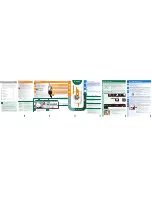
5
To find out whether your model allows fabric softener
dispenser usage and for information on ordering, refer to the
front page of this manual or call the dealer from whom you
purchased your washer/dryer. Ask for Part Number 3350834.
NOTE: Do not spill or drip any fabric softener onto the clothes.
Undiluted fabric softener can stain fabrics. Always dilute fabric
softener with warm water. Too much fabric softener can make
some items (diapers and towels) nonabsorbent. If this
happens, do not use it in every load, or use less of it in each
load.
Style 1: With liquid fabric softener dispenser (on some
models)
■
Use only liquid fabric softener in this dispenser. Pour
measured liquid fabric softener into the dispenser.
Softener is added automatically during the rinse portion of
the cycle. Dilute liquid fabric softener by filling the
dispenser with warm water until liquid reaches the
crossbar in the dispenser opening.
Style 2: Without liquid fabric softener dispenser (on some
models)
■
In the final rinse ONLY, add fabric softener that has been
diluted with
¹⁄₂
to 1 cup (125 to 250 mL) warm water.
4. Close the washer lid. Washer will not agitate or spin with the
lid open.
5. Turn the WATER LEVEL selector to the correct setting for your
wash load and the type of fabric being washed. You may
change the load size or water level selection after the washer
has started filling by turning the selector to a different setting.
6. Set the TEMPERATURE selector to the correct setting for the
type of fabric and soils being washed. Use the warmest water
safe for fabric. Follow garment label instructions.
NOTE: In wash water temperatures colder than 60ºF (15.6ºC),
detergents do not dissolve well. Soils can be difficult to
remove. Some fabrics can retain wear wrinkles and have
increased pilling (the formation of small lint-like balls on the
surface of garments).
7. Push in the Cycle Control knob and turn it clockwise to the
wash cycle you want. Reduce the wash time when using a
small load size setting. Pull out the Cycle Control knob to start
the washer.
To stop or restart your washer:
■
To stop the washer at any time, push in the Cycle
Control knob.
■
To restart the washer, close the lid (if open) and pull out the
Cycle Control knob.
DRYER USE
Starting Your Dryer
This booklet covers several different models. Your dryer may not
have all of the cycles and features described.
Before using your dryer, wipe the dryer drum with a damp cloth to
remove dust from storing and shipping.
1. Clean lint screen before each load. See “Cleaning the Lint
Screen.”
2. Load clothes loosely into the dryer and close the door. Do not
pack the dryer. Allow space for clothes to tumble freely.
3. Turn the Cycle Control knob to the recommended cycle for the
type of load being dried. Use the Energy Preferred Automatic
Setting to dry most heavy to medium weight fabrics.
4. (OPTIONAL) Your dryer may have an END OF CYCLE SIGNAL.
The signal is helpful when drying items that should be
removed from the dryer as soon as it stops. The End of Cycle
signal is part of the Start button and is selectable. Turn the
Start button to ON or OFF. The signal will sound only if the
selector is set to On.
5. If desired, add fabric softener sheet. Follow package
instructions.
6. Press the PUSH TO START button.
WARNING
Explosion Hazard
Keep flammable materials and vapors, such as
gasoline, away from dryer.
Do not dry anything that has ever had anything
flammable on it (even after washing).
Failure to follow these instructions can result in death,
explosion, or fire.
WARNING
Fire Hazard
No washer can completely remove oil.
Do not dry anything that has ever had any type of oil on
it (including cooking oils).
Items containing foam, rubber, or plastic must be dried
on a clothesline or by using an Air Cycle.
Failure to follow these instructions can result in death
or fire.






































